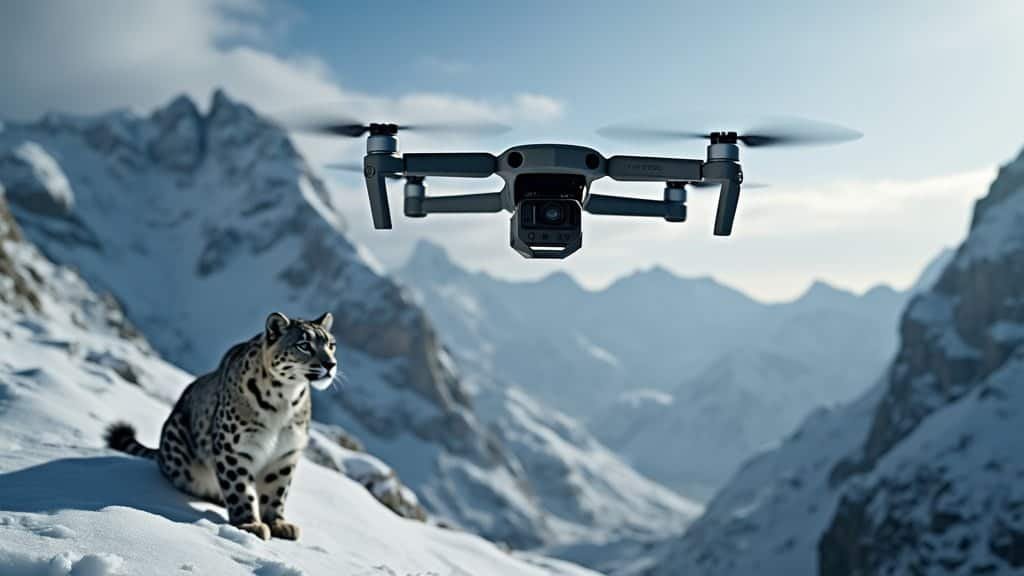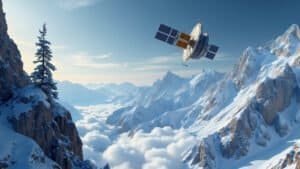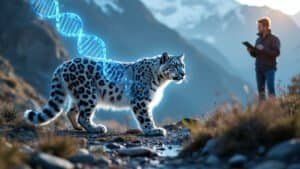Introduction
Monitoring snow leopard populations in the rugged, remote mountains of Central and South Asia has always been a significant challenge for conservationists. However, the advent of drone technology has revolutionized this process, providing a new and efficient way to track these elusive big cats
This article explores how drones are transforming snow leopard monitoring by utilizing advanced technology, capturing critical data, and overcoming the challenges of harsh terrains. We’ll also examine how drones are being deployed in these remote habitats and their role in enhancing snow leopard conservation efforts
How Drones Are Transforming Snow Leopard Monitoring
Drones have emerged as a game-changer in the conservation of snow leopards, offering unprecedented capabilities in monitoring these elusive predators. By flying over vast, rugged terrains where human access is limited, drones provide real-time data that helps researchers track and study snow leopard populations more effectively than ever before
This section delves into the specific technologies drones use, how they capture crucial images and data, and the strategies employed to overcome the challenges of monitoring in some of the world’s most inhospitable environments
Technology Used by Drones in Wildlife Monitoring
Drones equipped with advanced technology, such as high-resolution cameras, thermal imaging, and GPS, are essential tools in wildlife monitoring. For snow leopards, drones use infrared and thermal cameras to detect heat signatures in the cold mountainous regions where these cats live
This technology allows drones to spot snow leopards even at night or when they are camouflaged by their surroundings. Additionally, GPS tracking helps pinpoint the exact location of the animals, which is crucial for monitoring their movements and determining their range
Moreover, drones can be equipped with artificial intelligence (AI) software that helps in identifying snow leopards from the footage captured. This software can differentiate between snow leopards and other animals, ensuring accurate data collection
The integration of AI with drones also streamlines the data analysis process, allowing researchers to quickly process large amounts of video footage and extract relevant information
Capturing Images and Data of Snow Leopards
Capturing high-quality images and data of snow leopards is critical for understanding their behavior, population density, and health
Drones are capable of flying at high altitudes, which is particularly useful in the mountainous regions where snow leopards reside. Equipped with powerful zoom lenses and stabilizers, drones can capture detailed images from a safe distance without disturbing the animals
One of the significant advantages of using drones is their ability to access hard-to-reach areas that are otherwise inaccessible to humans. Snow leopards often inhabit steep cliffs and rugged terrains that are dangerous for researchers to explore on foot. Drones can navigate these challenging landscapes with ease, capturing images and videos that provide valuable insights into the leopards’ habitat and behavior
In addition to visual data, drones can also be used to collect environmental data, such as temperature, humidity, and altitude, which are essential for understanding the conditions in which snow leopards live
This data helps in creating detailed models of snow leopard habitats, aiding in conservation planning and efforts to protect these animals from threats such as climate change and habitat loss
Overcoming Challenges in Harsh Terrains
Operating drones in the harsh and unpredictable terrains of snow leopard habitats presents several challenges. The high altitudes, cold temperatures, and strong winds common in these regions can affect drone performance, potentially leading to technical issues or loss of control
However, advances in drone technology have led to the development of models specifically designed for high-altitude operations. These drones are built with robust materials, have longer battery life, and are capable of maintaining stability even in strong winds
Furthermore, the development of autonomous drones has been a significant breakthrough in overcoming these challenges. Autonomous drones can be pre-programmed to follow specific flight paths, ensuring they cover all necessary areas without human intervention
This capability is particularly useful in remote areas where communication signals might be weak, making it difficult to manually control the drones
Another challenge is the cold temperatures, which can drain drone batteries faster than usual. To mitigate this, drones designed for snowy environments are equipped with insulated battery compartments and heating systems to maintain optimal battery performance
Some drones also feature redundant systems, such as multiple batteries or backup navigation systems, to ensure they can complete their missions even in extreme conditions
By addressing these challenges, drones have become an indispensable tool in snow leopard monitoring, providing researchers with the means to gather critical data in some of the world’s most difficult environments
The Role of Drones in Snow Leopard Conservation
Drones have become a vital component in the conservation efforts aimed at protecting snow leopards. These advanced tools not only help in tracking and monitoring the elusive big cats but also play a crucial role in gathering data that drives conservation strategies
By providing detailed insights into snow leopard movements, behavior, and population dynamics, drones contribute significantly to the preservation of this endangered species
This section explores how drones are used in tracking snow leopards, compares them with traditional monitoring methods, and highlights their impact on conservation efforts
Tracking Movements and Population Dynamics
Drones are highly effective in tracking the movements and population dynamics of snow leopards, which is essential for understanding their behavior and ensuring their survival
Equipped with GPS and thermal imaging, drones can monitor snow leopards across vast and rugged terrains, capturing data that would be nearly impossible to gather through traditional methods. This data includes information on the leopards’ range, migration patterns, and interactions with other wildlife, which are critical for assessing their population health
The ability to track individual snow leopards over time provides conservationists with valuable insights into their life cycles, mating habits, and territorial behavior
For example, drones can be used to monitor how snow leopards adapt to changes in their environment, such as habitat fragmentation or climate change. This information is crucial for developing effective conservation strategies that address the specific needs of snow leopard populations
Additionally, drones help identify critical habitats that require protection, such as breeding sites or areas rich in prey. By mapping these areas, conservationists can prioritize their efforts and focus on safeguarding the most important regions for snow leopard survival
This targeted approach increases the effectiveness of conservation initiatives and helps allocate resources more efficiently
Comparing Drones with Traditional Monitoring Methods
Traditional methods of monitoring snow leopards, such as camera traps, field surveys, and tracking collars, have been used for decades. While these methods have provided valuable data, they also come with significant limitations
Camera traps, for instance, require setting up in specific locations, which can be time-consuming and labor-intensive. Moreover, they only capture images of animals that pass directly in front of them, missing out on a lot of activity that occurs elsewhere
Field surveys, on the other hand, involve physically tracking snow leopards, often in harsh and inaccessible terrain
This method is not only dangerous but also limited in scope, as it covers only small areas at a time. Tracking collars provide continuous data on individual animals, but they are invasive and can affect the behavior of the snow leopards
In contrast, drones offer a non-invasive, efficient, and comprehensive approach to monitoring snow leopards. They can cover large areas quickly and capture data from multiple locations simultaneously
Drones also minimize human presence in the animals’ habitat, reducing the risk of disturbing them. Moreover, drones can be deployed in a variety of weather conditions and terrains, making them a versatile tool for year-round monitoring
While traditional methods still play a role in snow leopard research, the integration of drones into conservation efforts has significantly enhanced the quality and quantity of data collected. By combining drone data with information from camera traps and tracking collars, conservationists can gain a more complete understanding of snow leopard populations and their needs
Enhancing Conservation Efforts with Drone Data
The data collected by drones is instrumental in shaping and enhancing conservation efforts for snow leopards. High-resolution images, videos, and environmental data gathered by drones provide a wealth of information that helps scientists and conservationists make informed decisions
For example, drone data can be used to model snow leopard habitats, predict the impact of environmental changes, and identify potential threats such as poaching or habitat destruction
Drones also facilitate community-based conservation initiatives by providing local communities with real-time information about snow leopard movements and potential conflicts with livestock. This information is crucial for mitigating human-wildlife conflict, which is one of the major threats to snow leopard populations
By alerting herders to the presence of snow leopards in their vicinity, drones help prevent retaliatory killings and promote coexistence between humans and wildlife
Furthermore, drones can be used to monitor the effectiveness of conservation interventions, such as anti-poaching patrols or habitat restoration projects. By providing up-to-date information on snow leopard populations and their habitats, drones enable conservationists to assess the success of their efforts and make necessary adjustments
Drones have become an indispensable tool in snow leopard conservation, offering a non-invasive, efficient, and comprehensive means of monitoring these elusive animals. By enhancing our understanding of snow leopard behavior and population dynamics, drones contribute significantly to the preservation of this endangered species
Deploying Drones in Remote Snow Leopard Habitats
Deploying drones in the remote and rugged habitats of snow leopards requires meticulous planning and the use of specialized technology. These areas, often characterized by steep mountains, extreme weather conditions, and limited accessibility, present unique challenges for drone operations
However, with the right strategies and equipment, drones can be effectively used to monitor snow leopards even in the most inhospitable environments
This section discusses the strategies for drone deployment in high altitudes, the limitations and potential issues faced, and real-world case studies showcasing successful drone-assisted monitoring efforts
Strategies for Drone Deployment in High Altitudes
Operating drones in high-altitude regions where snow leopards reside demands careful consideration of several factors, including the thin air, cold temperatures, and unpredictable weather
To successfully deploy drones in these conditions, conservationists and researchers use drones specifically designed or adapted for high-altitude flights. These drones are typically equipped with powerful motors and propellers that provide the necessary lift in thin air, as well as enhanced batteries that perform better in cold environments
Pre-mission planning is crucial for ensuring successful drone deployment. This involves mapping out the flight path, considering the terrain, and identifying potential obstacles such as cliffs or high winds
Advanced software allows operators to pre-program drones with precise flight paths that optimize coverage of the snow leopard’s habitat while avoiding dangerous areas
In addition, drones used in these regions often have features such as real-time GPS tracking, obstacle detection, and autonomous navigation capabilities. These features are essential for maintaining control over the drone in challenging conditions and ensuring that it can return safely after completing its mission
Autonomous drones, which can operate with minimal human intervention, are particularly valuable in these environments, as they can adapt to changing conditions and complete their missions even when communication with the operator is limited
Limitations and Potential Issues in Drone Usage
While drones offer significant advantages in monitoring snow leopards, they also come with certain limitations and potential issues. One of the primary challenges is battery life, which can be significantly reduced in cold temperatures
This limitation restricts the flight time of drones, requiring careful planning to ensure that they can complete their missions and return to base before the battery is depleted. In some cases, this may mean deploying multiple drones in shifts or using drones with extended battery capabilities
Another limitation is the potential for drones to disturb wildlife. Although drones are generally less intrusive than human presence, they can still cause stress or alter the behavior of snow leopards and other animals if not operated with care
To mitigate this, operators must maintain a safe distance from the animals and use drones that operate quietly. Additionally, flying at higher altitudes can reduce the likelihood of disturbing wildlife while still capturing the necessary data
Weather conditions also pose a significant challenge. Snow leopards inhabit regions where weather can change rapidly, with sudden snowstorms, high winds, or fog. These conditions can impede drone flights or lead to the loss of equipment
To address this, operators often deploy drones during specific weather windows and use weather-resistant models that can withstand harsh conditions
Lastly, the remoteness of snow leopard habitats means that retrieving data from drones can be difficult if they lose communication with the operator or crash in inaccessible areas. To overcome this, some drones are equipped with automated data transmission systems that send information back to base in real-time
Additionally, drones designed for rough terrain often include features like crash-resistant frames or emergency recovery systems that help protect the device and its data in case of an accident
Real-World Case Studies of Drone-Assisted Monitoring
The use of drones in monitoring snow leopards has been successfully implemented in various real-world scenarios, demonstrating their effectiveness in conservation efforts
For example, in the mountains of Mongolia, conservationists have used drones to survey vast areas of snow leopard habitat that would have been impossible to cover on foot. These drones captured high-resolution images and videos, allowing researchers to identify individual snow leopards and monitor their movements without disturbing them
In another case, drones were used in the Himalayas to study snow leopard populations across multiple regions. The data collected helped researchers estimate population sizes, identify key habitats, and assess the impact of human activities on snow leopard territories
This information was crucial in developing conservation strategies that targeted the most critical areas for snow leopard survival
Furthermore, drones have been deployed in Kyrgyzstan to monitor the effects of climate change on snow leopard habitats. By capturing detailed environmental data over time, drones provided insights into how changing temperatures and snow cover were affecting the availability of prey and the movement patterns of snow leopards
This data is being used to inform conservation policies aimed at mitigating the impact of climate change on these vulnerable populations
These case studies highlight the versatility and effectiveness of drones in snow leopard conservation. They demonstrate that, despite the challenges, drones are a powerful tool for gathering the data needed to protect these elusive big cats and ensure their survival in the wild
Conclusion
Drones have revolutionized the monitoring and conservation of snow leopards by providing innovative solutions to the challenges posed by their remote and rugged habitats. Through advanced technologies like thermal imaging, GPS, and AI, drones offer a non-invasive, efficient, and comprehensive way to track these elusive big cats, gather critical data, and enhance conservation efforts
From capturing high-resolution images and monitoring movements to overcoming the difficulties of high-altitude operations, drones have proven to be indispensable tools in the fight to protect snow leopards
As drone technology continues to advance, it holds the potential to further improve our understanding of snow leopards and bolster the ongoing efforts to preserve this endangered species for future generations






